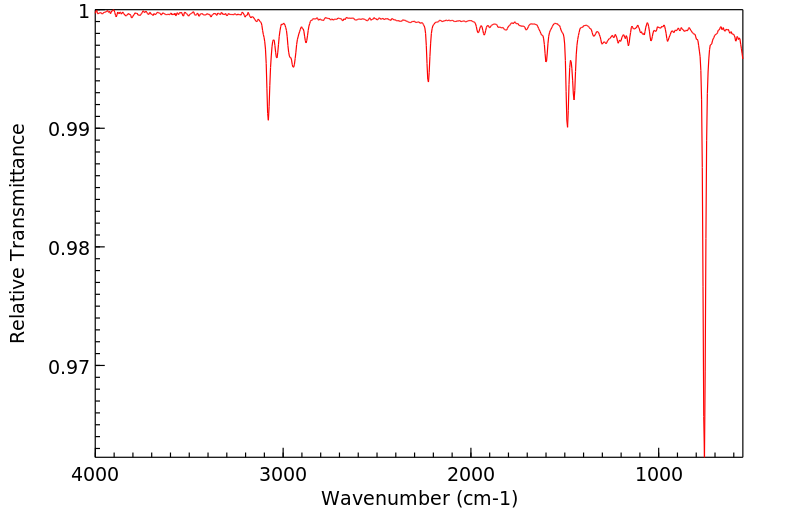1,2-bis(2-cyanophenyl)ethane | 10270-33-4
中文名称
——
中文别名
——
英文名称
1,2-bis(2-cyanophenyl)ethane
英文别名
bibenzyl-2,2'-dicarbonitrile;1.2-Bis-(2-cyan-phenyl)-aethan;Bibenzyl-2,2'-dicarbonitril;2.2'-Dicyan-dibenzyl;1,2-bis(2-cyano-phenyl)-ethane;2,2'-Ethane-1,2-diyldibenzonitrile;2-[2-(2-cyanophenyl)ethyl]benzonitrile
CAS
10270-33-4
化学式
C16H12N2
mdl
——
分子量
232.285
InChiKey
ZCFUFVAJHLGQQR-UHFFFAOYSA-N
BEILSTEIN
——
EINECS
——
-
物化性质
-
计算性质
-
ADMET
-
安全信息
-
SDS
-
制备方法与用途
-
上下游信息
-
文献信息
-
表征谱图
-
同类化合物
-
相关功能分类
-
相关结构分类
计算性质
-
辛醇/水分配系数(LogP):3.6
-
重原子数:18
-
可旋转键数:3
-
环数:2.0
-
sp3杂化的碳原子比例:0.12
-
拓扑面积:47.6
-
氢给体数:0
-
氢受体数:2
反应信息
-
作为反应物:描述:参考文献:名称:Fuson, Journal of the American Chemical Society, 1926, vol. 48, p. 834摘要:DOI:
-
作为产物:描述:邻甲基苯腈 在 N-溴代丁二酰亚胺(NBS) 、 caesium carbonate 、 copper(I) bromide 、 过氧化苯甲酰 作用下, 以 四氯化碳 、 水 、 丙酮 、 乙腈 为溶剂, 反应 12.0h, 生成 1,2-bis(2-cyanophenyl)ethane参考文献:名称:铜促进硫氰酸苄酯二聚得到功能化联苄摘要:联苄衍生物的合成由于其多样化的药理学和合成应用而在有机化学中具有重要意义。在此,我们报道了一种新型的铜促进的二聚反应,用于从硫氰酸苄酯有效合成官能化联苄。偶联反应在有氧和温和的条件下通过级联 C-S 键裂解在一锅中进行。多种取代基,包括芳环上的吸电子基团,具有良好的耐受性,能够以中等至良好的产率提供所需的产物。所开发的方案可用于从两种不同的缺电子硫氰酸苄酯获得交叉偶联产物。DOI:10.1055/a-2330-9955
文献信息
-
Direct preparation of benzylic manganese reagents from benzyl halides, sulfonates, and phosphates and their reactions: applications in organic synthesis作者:YoungSung Suh、Jun-sik Lee、Seoung-Hoi Kim、Reuben D RiekeDOI:10.1016/s0022-328x(03)00500-x日期:2003.11The use of highly active manganese (Mn)*, prepared by the Rieke method, was investigated for the direct preparation of benzylic manganese reagents. The oxidative addition of the highly active manganese to benzylic halides was easily completed under mild conditions. Moreover, benzylic manganese sulfonates and phosphates were prepared by direct oxidative addition of Mn* to the carbon–oxygen bonds of
-
An amphiphilic, catalytically active, vitamin B<sub>12</sub> derivative作者:M. Giedyk、S. N. Fedosov、D. GrykoDOI:10.1039/c4cc01064g日期:——
The reaction of vitamin B12 with DMF-DMA and MeOH as a nucleophile affords cobalester, the first amphiphilic cobalamin derivative which is able to catalyze C–C bond forming reactions.
-
Mixed Alkyl/Aryl Diphos Ligands for Iron‐Catalyzed Negishi and Kumada Cross Coupling Towards the Synthesis of Diarylmethane作者:Xufeng Ma、Han Wang、Yao Liu、Xing Zhao、Jun ZhangDOI:10.1002/cctc.202101237日期:2021.12.15C−C coupling: Iron catalysts supported by mixed alkyl/aryl diphos ligands exhibited efficient reactivities in both Negishi and Kumada coupling towards the synthesis of diarylmethane with enhanced activity and selectivity. The electron-rich mixed PPh2/PCy2 ligands outperformed their symmetrical PPh2 congeners, and led to decreased homocoupling byproduct formation.
-
REDUCTIVE COUPLING OF BENZYL HALIDES USING NICKEL(0)-COMPLEX GENERATED IN SITU IN THE PRESENCE OF TETRAETHYLAMMONIUM IODIDE, A SIMPLE AND CONVENIENT SYNTHESIS OF BIBENZYLS作者:Masahiko Iyoda、Masahiro Sakaitan、Hiroki Otsuka、Masaji OdaDOI:10.1246/cl.1985.127日期:1985.1.5Zerovalent nickel complex generated in situ by reduction of NiBr2(PPh3)2 with zinc powder in the presence of Et4NI was found to be an effective catalyst for homo-coupling of benzyl halides. The catalytic reactions proceeded smoothly in various solvents under mild conditions to afford dehalogenative-coupling products in good to high yields.
-
Copper catalyzed oxidation of organozinc halides
表征谱图
-
氢谱1HNMR
-
质谱MS
-
碳谱13CNMR
-
红外IR
-
拉曼Raman
-
峰位数据
-
峰位匹配
-
表征信息
同类化合物
(E,Z)-他莫昔芬N-β-D-葡糖醛酸
(E/Z)-他莫昔芬-d5
(4S,5R)-4,5-二苯基-1,2,3-恶噻唑烷-2,2-二氧化物-3-羧酸叔丁酯
(4S,4''S,5R,5''R)-2,2''-(1-甲基亚乙基)双[4,5-二氢-4,5-二苯基恶唑]
(4R,5S)-4,5-二苯基-1,2,3-恶噻唑烷-2,2-二氧化物-3-羧酸叔丁酯
(4R,4''R,5S,5''S)-2,2''-(1-甲基亚乙基)双[4,5-二氢-4,5-二苯基恶唑]
(1R,2R)-2-(二苯基膦基)-1,2-二苯基乙胺
鼓槌石斛素
黄子囊素
高黄绿酸
顺式白藜芦醇三甲醚
顺式白藜芦醇
顺式己烯雌酚
顺式-白藜芦醇3-O-beta-D-葡糖苷酸
顺式-桑皮苷A
顺式-曲札芪苷
顺式-二苯乙烯
顺式-beta-羟基他莫昔芬
顺式-a-羟基他莫昔芬
顺式-3,4',5-三甲氧基-3'-羟基二苯乙烯
顺式-1-(3-甲基-2-萘基)-2-(2-萘基)乙烯
顺式-1,2-双(三甲基硅氧基)-1,2-双(4-溴苯基)环丙烷
顺式-1,2-二苯基环丁烷
顺-均二苯乙烯硼酸二乙醇胺酯
顺-4-硝基二苯乙烯
顺-1-异丙基-2,3-二苯基氮丙啶
非洲李(PRUNUSAFRICANA)树皮提取物
阿非昔芬
阿里可拉唑
阿那曲唑二聚体
阿托伐他汀环氧四氢呋喃
阿托伐他汀环氧乙烷杂质
阿托伐他汀环(氟苯基)钠盐杂质
阿托伐他汀环(氟苯基)烯丙基酯
阿托伐他汀杂质D
阿托伐他汀杂质94
阿托伐他汀杂质7
阿托伐他汀杂质5
阿托伐他汀内酰胺钠盐杂质
阿托伐他汀中间体M4
阿奈库碘铵
锌(II)(苯甲醛)(四苯基卟啉)
银松素
铜酸盐(5-),[m-[2-[2-[1-[4-[2-[4-[[4-[[4-[2-[4-[4-[2-[2-(羧基-kO)苯基]二氮烯基-kN1]-4,5-二氢-3-甲基-5-(羰基-kO)-1H-吡唑-1-基]-2-硫代苯基]乙烯基]-3-硫代苯基]氨基]-6-(苯基氨基)-1,3,5-三嗪-2-基]氨基]-2-硫代苯基]乙烯基]-3-硫代
铒(III) 离子载体 I
铀,二(二苯基甲酮)四碘-
钾钠2,2'-[(E)-1,2-乙烯二基]二[5-({4-苯胺基-6-[(2-羟基乙基)氨基]-1,3,5-三嗪-2-基}氨基)苯磺酸酯](1:1:1)
钠{4-[氧代(苯基)乙酰基]苯基}甲烷磺酸酯
钠;[2-甲氧基-5-[2-(3,4,5-三甲氧基苯基)乙基]苯基]硫酸盐
钠4-氨基二苯乙烯-2-磺酸酯







